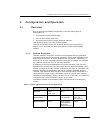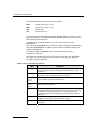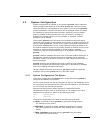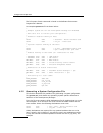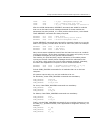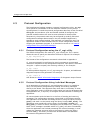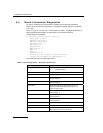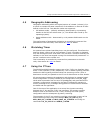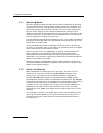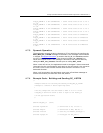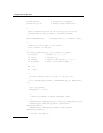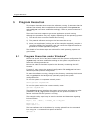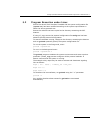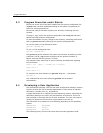
Dialogic
®
DSI SPCI Network Interface Boards Programmer's Manual Issue 5
27
4.5 Geographic Addressing
Geographic Addressing allows the logical position of a board (or board_id) in
a system to remain the same irrespective of the addition or removal of other
boards on the PCI bus. Two address modes are supported:
• PCI address mode – (default) addressing determined by enumerating
boards on the PCI bus at boot time (i.e., the default order found by the
operating system).
• Switch address mode - determined by a 16 position ADDR switch on the
board.
The configuration of Geographic Addressing is controlled by command line
parameters to the ssds utility. See section 8.1 ssds
for details.
4.6 Watchdog Timer
An optional host to board watchdog timer may be configured. This allows the
board to detect a failure of the host software. If such a condition is detected,
then the board goes into a reset state. This prevents a condition whereby the
software on the host has stopped running but the boards still presents an "in-
service" condition to the remote end.
This functionality is controlled by command line parameters to the ssds
utility. See section 8.1 ssds
for details.
4.7 Using the CT bus
The SPCI2S and SPCI4 boards support two or four T1/E1 Line Interface Units
and a CT bus interface (H.100) respectively. The on-board signaling processor
handles the SS7 signaling timeslots whilst the remaining circuits (voice or
data bearer circuits) are passed to the CT bus for distribution to other boards.
All communication between the application and the board is message-based.
Initial configuration is usually handled by the configuration utility s7_mgt,
which takes commands from the text file (config.txt) and generates all the
necessary configuration messages for the board. Subsequent operation is
entirely message driven, messages being passed in both directions between
the board and the application.
One of the roles of the application is to control the dynamic switching
between the CT bus and the T1/E1 line interfaces. This section provides
details of how to interface with the CT bus, including the initial (static)
configuration and the subsequent (dynamic) switching.
The operation of the CT bus switching interface is described in terms of the
SCbus switching model using the messages MVD_SC_DRIVE_LIU,
MVD_MSG_SC_LISTEN and MVD_MSG_SC_FIXDATA and config.txt
commands LIU_SC_DRIVE and SCBUS_LISTEN.



